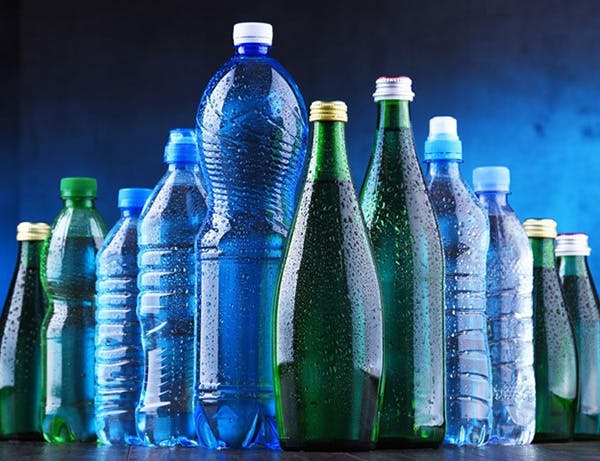October 2022
PFAS in Water: Should You Be Concerned?
Since the 1940s, PFAS have polluted our water supplies. But it’s only been in the last 20 years that the general public has begun to understand what PFAS in water means for human health. As scientific research continues to fill in the gaps in our understanding, we want to help you protect yourself and your family from this public health menace.
What Are PFAS?
PFAS, or perfluoroalkyl and polyfluoroalkyl substances, are a class of man-made chemicals used as a barrier between other substances. Think nonstick cookware, the stain-resistant treatment on your carpet, or the coating inside a microwave popcorn bag that keeps the grease from soaking through the bag. Most nonstick products or those considered water-, grease-, or stain-resistant use PFAS.
PFAS work well because they have a very stable chemical structure. They don’t react to heat or other chemicals, so they’re great for forming protective barriers that don’t break down. Unfortunately, this also means they don’t break down in the environment — or your body.
According to the Agency for Toxic Substance and Disease Registry (ATSDR), most people in the U.S. now have at least some traces of PFAggS in their blood.
Some PFAS are being phased out in the U.S. due to public health risks.
However, they’re still in our environment because they don’t break down. They last so long people refer to them as forever chemicals.
What Are the Public Health Risks of PFAS?
There are many types of PFAS chemicals. Since the 1940s and 50s, the most widely used have been perfluorooctanoic acid (PFOA) and perfluorooctane sulfonic acid (PFOS). The heavy use of these two PFAS makes them the main focus of attention for environmental and health groups across the U.S.
Because of their long-term use and not breaking down, the level of PFAS in water systems, our environment, and our bodies has increased over the decades. Although levels of PFOA and PFOS in our blood peaked in the early 2000s, the introduction of new chemical compounds to replace them has many considering this a human health crisis.
What Do We Know About PFAS?
In 2000, 3M — the materials company and a major producer of PFAS — came forward publicly due to concerns about the accumulation of these compounds over time. Because of the known potential negative health effects that PFAS can cause, 3M committed to phasing out some uses of PFOA and PFOS in certain products by 2002.
Over the next few years, officials discovered the drinking water of thousands of people in Ohio and West Virginia was reportedly contaminated by a DuPont factory PFOA). The lawsuits over this ongoing contamination continue to this day.
These lawsuits sparked several voluntary programs to phase out most uses of PFOA and PFOS in the United States. These two popular chemicals were mostly replaced by newer and less-tested versions like GenX and PFBS.
Are PFBS and GenX Safe?
As research continues on all four of these chemicals, there’s increasing evidence that PFBS and GenX may pose the same health and environmental risks as the PFOA and PFOS they’re replacing.
According to the CDC, that’s a problem as PFOA and PFOS have been linked to:
- Higher cholesterol levels
- Changes in liver enzymes
- Lower vaccine response in children
- Higher risk of high blood pressure or pre-eclampsia in pregnant women
- Small decreases in infant birth weights
- Increased risk of kidney or testicular cancer
Scientists continue to research the dangers of PFAS. Studies so far have raised enough concern for the U.S. Environmental Protection Agency (EPA) to keep lowering recommended limits for PFAS in water supplies.

What Level of PFAS in Water Is Dangerous?
According to the Environmental Working Group, we should be aiming for a maximum of 1 ppt (part per trillion) total PFAS in water due to issues with vaccine effectiveness in children.
The U.S. Environmental Protection Agency, on the other hand, says the fewer the better. While introducing its updated “Lifetime Drinking Water Health Advisory” for 2022, the EPA said:
“The updated advisory levels, which are based on new science and consider lifetime exposure, indicate that some negative health effects may occur with concentrations of PFOA or PFOS in water that are near zero.”
They went on to dramatically lower their 2016 lifetime health advisory levels for PFOA and PFOS while adding first-time advisories for GenX and PFBS.
These new limits are:
- PFOA: 0.004 ppt
- PFOS: 0.02 ppt
- GenX chemicals: 10 ppt
- PFBS: 2,000 ppt
It’s likely as new research comes out these recommendations will continue to decrease, particularly in GenX and PFBS, which are currently being allowed at much higher levels than their predecessors.
Until we better understand the effects of these chemicals, it’s up to us to make the best decisions for the health of ourselves, our families, and our communities as the chemical companies continue to prove they aren’t going to do it for us.
The Role of Chemical Companies
With several class action lawsuits filed and various voluntary PFA phase-out programs coming from U.S. regulatory agencies, many companies saw the writing on the wall and phased out usage of PFOA and PFOS.
DuPont — the inventor of PFAS that profited from their use since the 1940s — decided instead to spin off its PFA division into its own S&P 400 company called Chemours. The two companies have been locked in legal battles to determine which is responsible for the ballooning environmental and health costs caused by decades of PFAS usage.
In 2017, Chemours’ license to dispose of wastewater in the state of North Carolina was revoked for repeated unreported spills into the Cape Fear River. There are now over 3,000 square miles of contamination in the river that serves as a drinking water supply for hundreds of thousands of people.
Chemours is currently trying to expand operations in the area.
Are PFOA and PFOS Banned?
While most products in the U.S. have shifted away from the more-known PFOA and PFOS and toward the newer and less-studied PFBS and GenX, there’s no federal regulation against any of them.
The FDA has removed approval for use of some PFAS in food packaging, but this was done because the last manufacturer using these chemicals abandoned the practice on their own. This made the approval to use these compounds no longer necessary.
Seven states have since decided to enact their own bans on selling foods with packaging containing intentionally added PFAS — the first of which goes into effect in New York at the end of 2022. As mentioned, though, companies have already done this on their own when it comes to food packaging, so these state bans seem more symbolic than anything.
Other states soon to be enacting laws against the use of PFAS in food packaging are California, Maine, Vermont, Washington, Connecticut, and Minnesota. Several others are considering them.
So far, all federal programs created to limit these contaminants by regulatory agencies have been voluntary to comply with.
Likewise, the recommendations from the EPA about limits in drinking water are only considered health advisories and are not enforceable.
Where Are the Greatest Risks of PFAS Exposure?
A lot of these forever chemicals have been produced over the last 80 years, which is a lot of time for accumulation to happen. There’s no shortage of ways you can be exposed to PFAS, including PFOA and PFOS. Here are a few to look out for.
PFAS in Water
PFAS in water — and even PFAS in sparkling water— brings the biggest threat of exposure. For decades, the production and use of products containing PFAS have contaminated our groundwater, rivers, lakes, and other surface water. Once contaminated, it’s extremely hard to clean it up.
Consumer Products
Thousands of everyday products now contain at least one type of PFAS. Everything from cosmetics to household cleaners to your clothing can contain them. If a product claims to be grease-, water-, or stain-resistant, this can be a red flag. Nonstick cookware, firefighting foams, and rug cleaners are also common culprits.
In a recent test of 231 different cosmetics, 52% were found to contain PFAS even though most weren’t labeled as such. Some popular brands contained as many as 13 different PFAS compounds.
Some Foods
According to the U.S. Food and Drug Administration, certain foods like fish from contaminated waterways or canned clams from China have been found to have very high concentrations of PFAS.
Dust Particles in the Air
Although PFAS don’t break down, they do end up in the air in dust particles through factory waste and the various products that contain them.
Pregnancy and Breastfeeding
In the 1970s, 3M began measuring PFAS contamination in human blood. Like in the environment, it takes a very long time for PFAS to break down in our bodies.
During pregnancy, PFAS in the blood transfer to the unborn child and also into the nursing mother’s breast milk.
While the effects of exposure to PFAS through breast milk aren’t heavily studied yet, current recommendations are to continue to breastfeed when possible. Breastfeeding has many benefits to the health of both the mother and baby that, according to the CDC, outweigh the dangers.
PFAS in Bottled Water and Sparkling Water
There’s been a lot of talk recently about PFAS in bottled water.
In 2020, a Consumer Reports study tested 47 brands for toxins like heavy metals and PFAS. While most of the brands did fine on the heavy metals, there were many concerns when it came to the levels of PFAS. This was particularly true when measuring PFAS in sparkling water brands.
The source of the excess PFAS in the carbonated water was unclear. It could have been the source water, poor filtration, or something in the manufacturing process.
Of the brands tested, these seven did the worst:

Topo Chico is owned by Coca-Cola. When asked for comment, the company responded that it would “continue to make improvements to prepare for more stringent standards in the future.”
To Coke’s credit, the next Consumer Reports test showed a dramatic reduction in PFAS after the beverage maker improved its filtering. The second test saw levels drop by over half to 3.9 ppt.
With this improvement and many brands scoring under 1 ppt in the first PFAS testing, it shows what these brands are capable of if they’re pushed.
What Government Resources Are Available to Help Me Avoid PFAS?
For more government resources and information to help you avoid harmful PFAS, check out this helpful guide from the U.S. EPA.
You can also check out this fact sheet on how to talk to your doctor if you’ve been exposed to PFAS.
You can also talk to your local water supplier about what they’re doing to limit community exposure. The EPA encourages citizens to inquire about the test results or if they test for PFA contaminant levels.
Protecting Yourself from PFAS
Avoiding PFAS altogether is not possible but you can limit your exposure. Carefully choosing the products you bring into your home will help. However, what about the PFAs in water being piped into your home every day?
A study of water filters from Duke University showed mixed results on many water filters but there was a consistent class of winners. Under-counter two-stage filters and under-counter reverse osmosis filters reliably filtered out 94% of PFAs from tap water. Countertop filters and even some whole home filters were not so reliable.
HomeWater has two under-counter filters to keep your family safe. Check out the best-selling HomeWater EZChange 2-Stage Under Counter Under Sink Water Filter or for ultimate contaminant reduction, take a look at our HomeWater 4-Stage Reverse Osmosis Under Counter Under Sink Water Filter.
Brought to you by homewater.com
All images licensed from Adobe Stock.


